A Gantt chart is a visual tool that helps project managers plan and schedule projects. It’s basically a stacked bar chart that breaks down the project’s tasks and places them on a timeline in chronological order.
There are several tools that can be used to create a Gantt chart, such as Excel, Google Sheets and project management software. In this blog, we’ll explore the pros and cons of creating a Gantt chart in Google Sheets.
We’ll also show you how to make a Gantt Chart in Google Sheets in six simple steps or, if you prefer, you can simply use our free Excel or Google Sheets Gantt chart template.
Why Use a Gantt Chart Template for Google Sheets?
Google Sheets is Google’s version of a spreadsheet which makes it a competitor of Microsoft Excel. The major difference between the two is that Google’s software is a cloud-based free tool that’s much better suited for team collaboration.
While Excel Gantt chart templates are popular, sharing them among your team members is time-consuming as Excel files must be downloaded and shared every time someone makes changes to the Gantt chart.
Google Sheet Gantt charts on the other hand, allow team members to collaborate in real-time without having to download any files. This means all your team members can access the same Gantt chart, leave comments and make changes to it at the same time.
However, while a Google Sheets Gantt chart is better than Excel when it comes to collaboration, it still falls short when compared to project management software like ProjectManager. ProjectManager offers fully featured Gantt charts that allow you to allocate resources, track projects in real-time, find the critical path and much more.
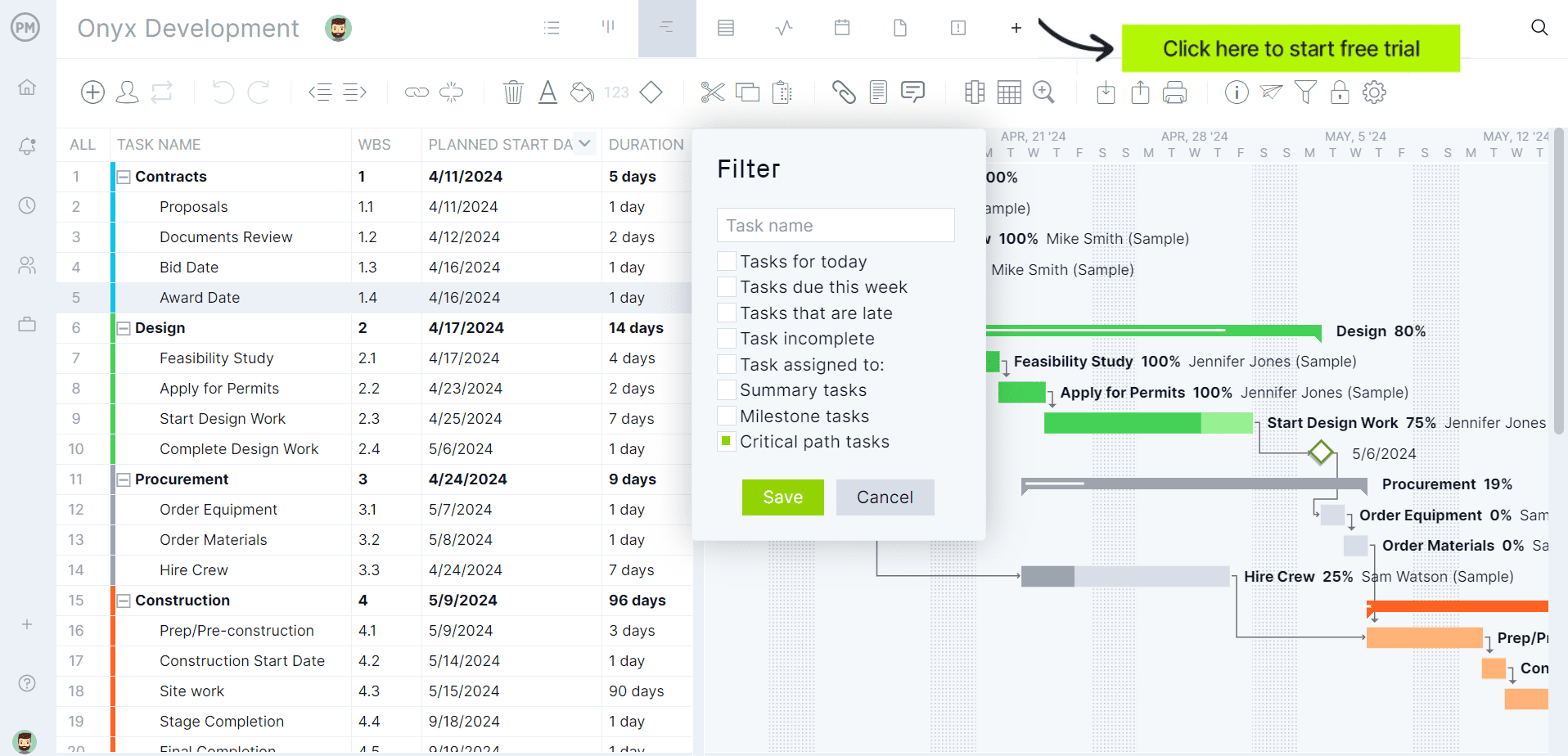
Free Gantt Chart Template for Google Sheets
We’ve created a free Gantt chart template for Google Sheets to help you plan and schedule projects with your team. Once you click on the link, you’ll access the template in a view-only mode.
Then, you’ll need to make a copy of your own so you can edit and share. You can then select who to share the Gantt chart Google Sheets template with and the permissions for each team member. You can share it as a view-only or as an editable Google Sheets spreadsheet.
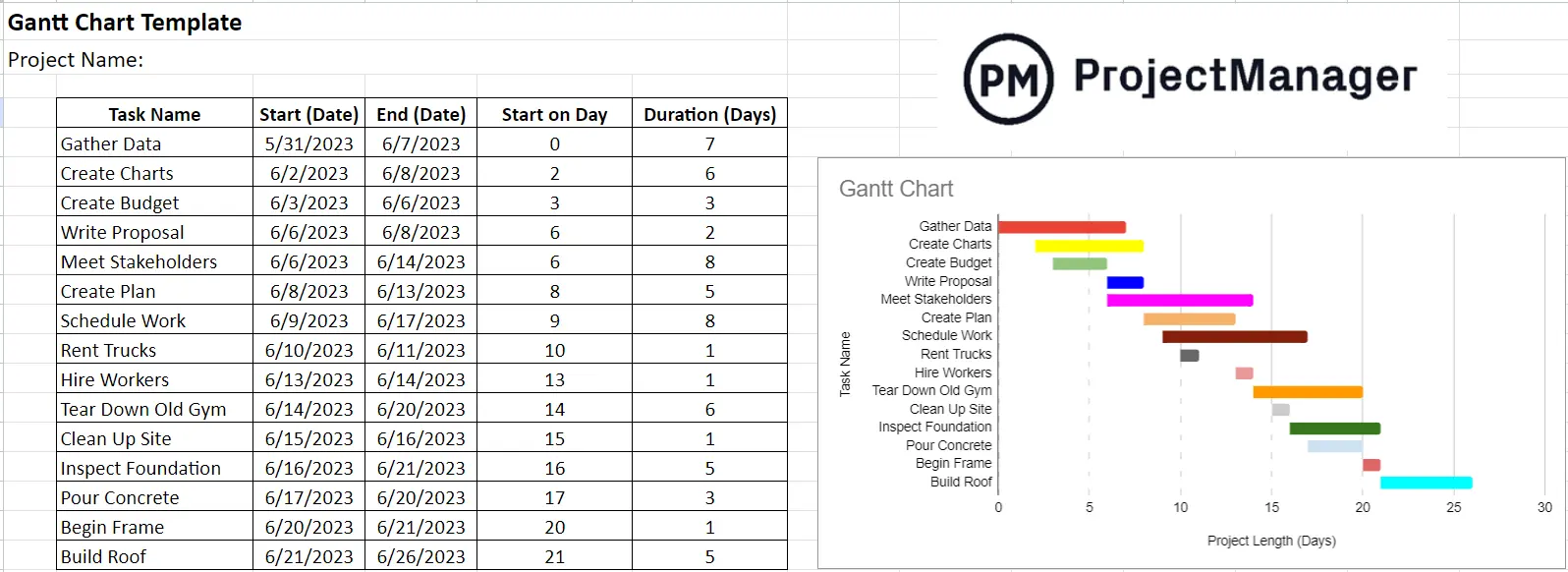
Google Sheet Gantt Chart Template: Pros & Cons
Making a Gantt chart in Google Sheets is a great free alternative to Excel or more robust project management software. There are some downsides, however, which can possibly make Google Sheets a less-than-ideal solution for your needs.
Here are some of the advantages and disadvantages of creating a Gantt chart in Google Sheets:
Pros of Making a Gantt Chart in Google Sheets
- The software is easy to use and can learn quickly.
- Your work is easily shareable through links. There’s no need to download files.
- A Google Sheet Gantt chart is fully integrated with other Google products.
- Your team members can collaborate in real time, which isn’t possible with an Excel Gantt chart.
Cons of Making a Gantt Chart in Google Sheets
- Google Sheets is not a Gantt chart maker or a project management tool.
- It’s not great with complex projects.
- You can’t set milestones on a Gantt chart in Google sheets.
- You’re not able to link dependent tasks on your Gantt chart.
- A Google sheet won’t let you manage resources and costs.
- You won’t be able to assign tasks on a central platform.
- You have to manually update your sheet to show progress.
Making a Gantt chart on Google Sheets is fine if you’re managing a simple project and already using other Google tools. However, if you’re managing a more complicated project or just want to have integrated features to track, monitor and report on your progress and performance, you’ll have to use a real Gantt chart tool.
Related: Project Management Templates for Google Sheets
ProjectManager’s Gantt Chart Is Better than a Google Sheets Gantt Chart
Google Sheets isn’t Gantt chart software and will only get you so far. You can’t link dependencies, set milestones, assign your team from the Gantt, monitor their progress and easily share and collaborate to the extent that you can with ProjectManager.
If you find that you’ve run into a wall, it’s time to try ProjectManager and see what a Gantt chart tool can do without giving you a headache. Our award-winning project management software organizes all your tasks, your team and your project for greater efficiency. Our project management software offers a powerful Gantt chart maker that was designed for project managers and has features that make it a much superior alternative to Excel and Google Gantt chart templates.
Importing a Google Sheets Gantt Chart in ProjectManager
Google spreadsheets weren’t designed for making Gantt charts. If you’re looking for a Gantt chart that’s easy to make, update and works with all the features you need to manage your project, you need project management software. ProjectManager is award-winning project management software that has interactive Gantt charts to help you plan and schedule your project.
Creating a Gantt chart in our tool is simple and free for 30 days when you take our trial. It’s far more dynamic than what a Google spreadsheet offers. To follow along, try ProjectManager for free by clicking here, and if you like it, there are three tiers to subscribe to after your 30-day trial is over. Let’s learn how to create a Gantt chart with ProjectManager step by step.
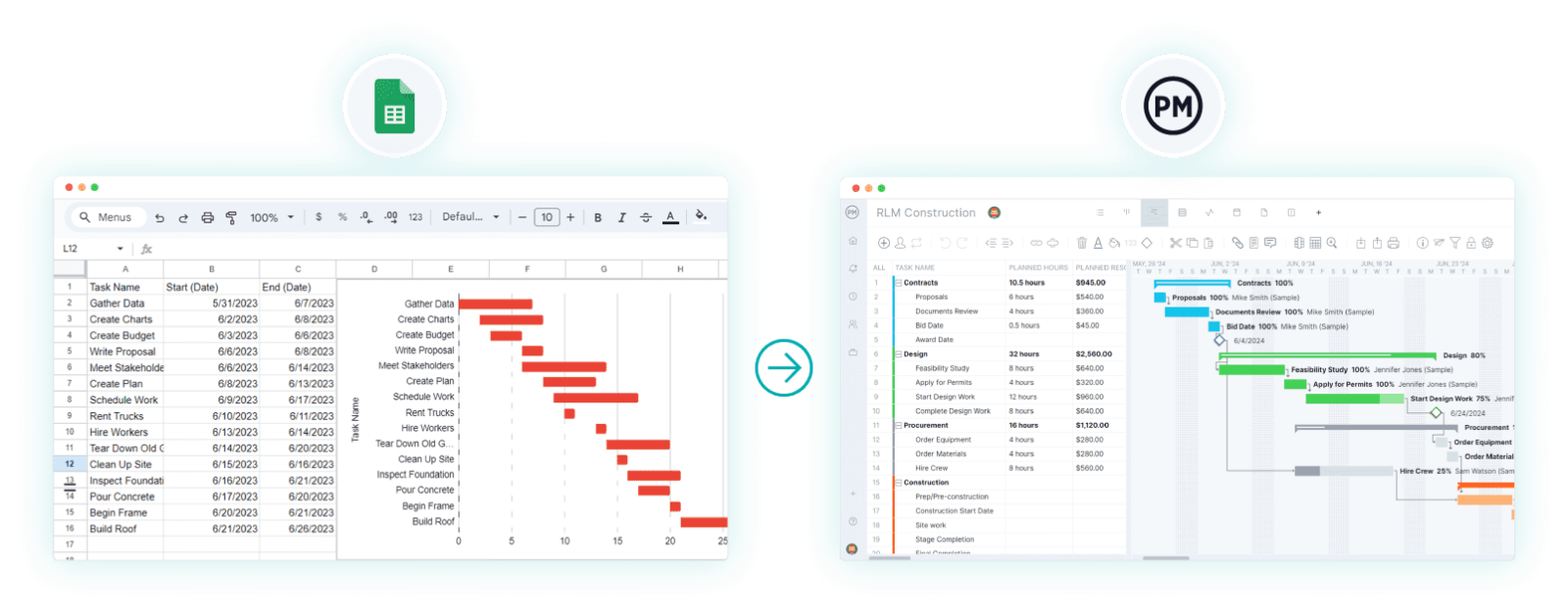
1. Import Your Google Sheet Gantt Chart
Export your Google Sheet Gantt chart as an Excel spreadsheet and import it into our tool. You can also use one of our industry-specific templates, or just add tasks to the Gantt chart tool manually. These features make it easy to make a Gantt chart in minutes.
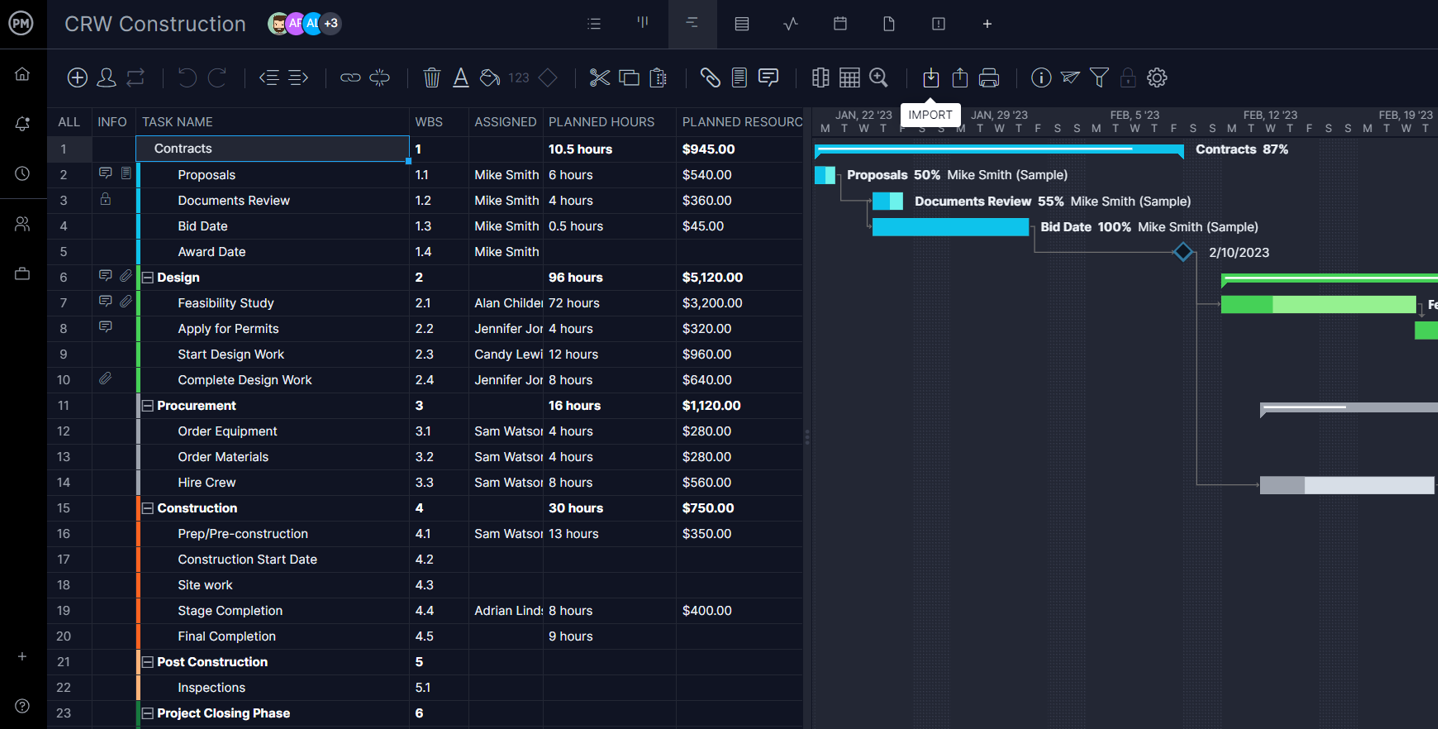
2. Add Task Duration to the Gantt Chart
Set the start and end dates for each of the tasks and they’ll populate the Gantt timeline. The start and end dates are connected by a color-coded duration bar, which indicates progress by its shading. The percent complete column allows team members to update their task status and allows project managers to track progress with the bar graph in real time.

3. Link Task Dependencies & Set Milestones on the Timeline
Connect project tasks that are dependent on other tasks to start or end to avoid bottlenecks. Then break the project into more manageable phases, or note important dates by setting milestones.
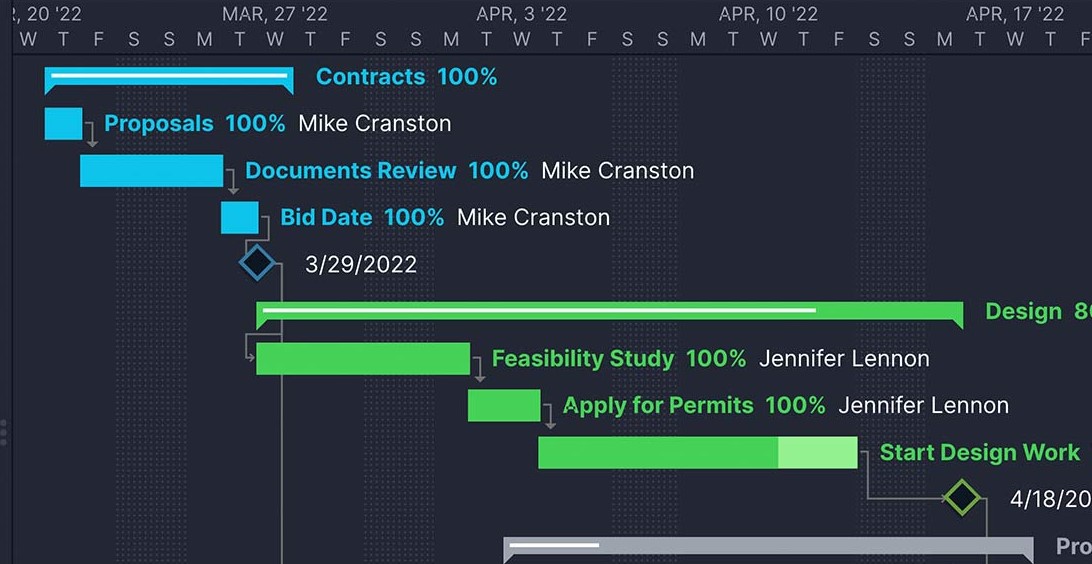
4. Assign Work and Share With Stakeholders
Start assigning tasks to your team so they know exactly what they need to work on. Plus, as they complete their tasks, progress is updated in real time on the percent complete column so you can track your schedule. Save your Gantt as a PDF and email it to project stakeholders to keep them in the loop or you can print out a copy to use in presentations. You now have a fully functioning Gantt chart!
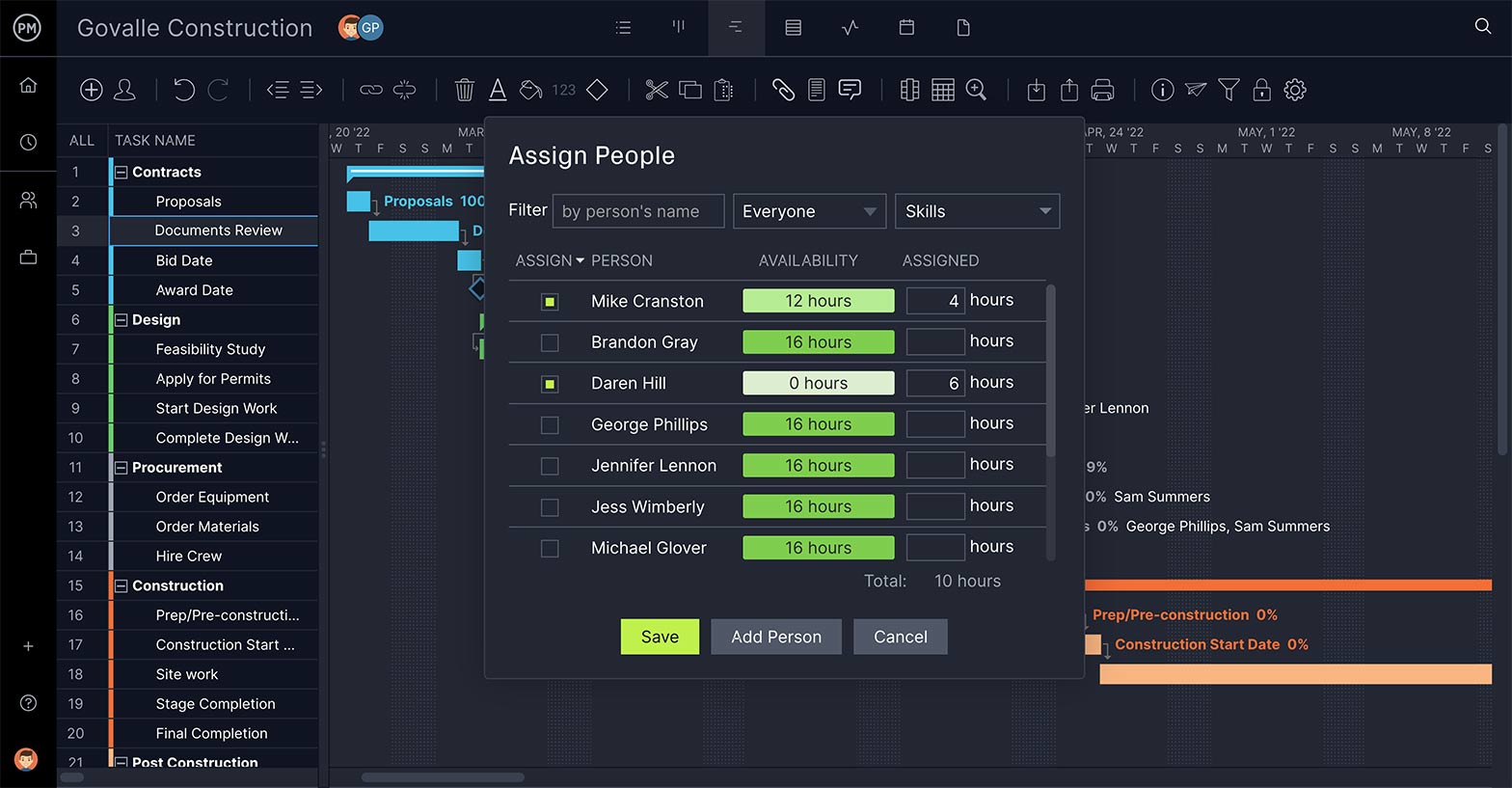
How to Make a Gantt Chart in Google Sheets
Like any other Gantt chart, a Google Sheets Gantt chart has two main parts: a table in which you’ll list your tasks, their duration and due dates and a stacked bar chart, which is a visual representation of the project schedule.
Here are the steps you’ll need to follow to make a Gantt chart in Google Sheets. The final result should look like the free Google Sheets Gantt chart template referenced above.
1. List Your Tasks & Due Dates on the Left Hand Side of the Google Sheets Gantt Chart
The first thing that you’ll need to do to create your Gantt chart in Google Sheets is to create three columns. Start by listing your project tasks in the first column along with their start date and end date to define your project timeline. Make sure to follow the format below (month/day/year).
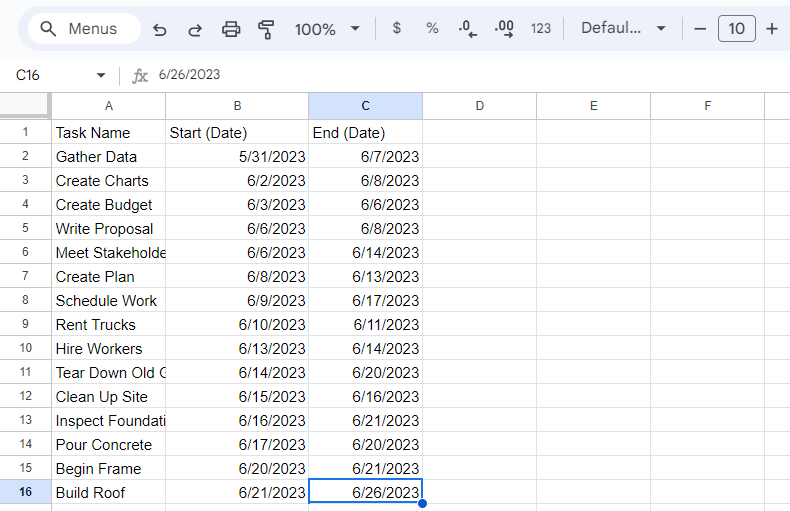
2. Create a “Start on Day” Column in Google Sheets
Now, type “start on day” as the title for the column that will go beside the end (date) column as shown below. Then, enter the formula “=B2-$B$2.” This column will be necessary when creating the stacked bar chart of your Gantt chart.
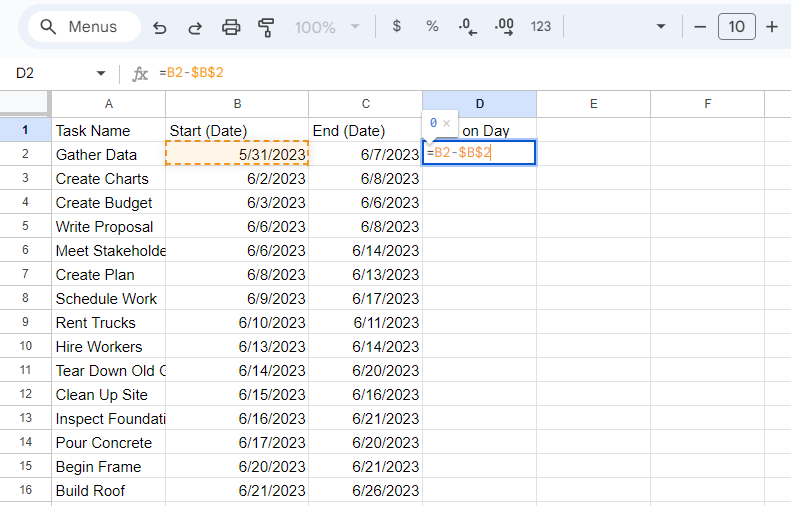
Once you enter the formula on the first row, Google Sheets will suggest you autofill the rest of the column.
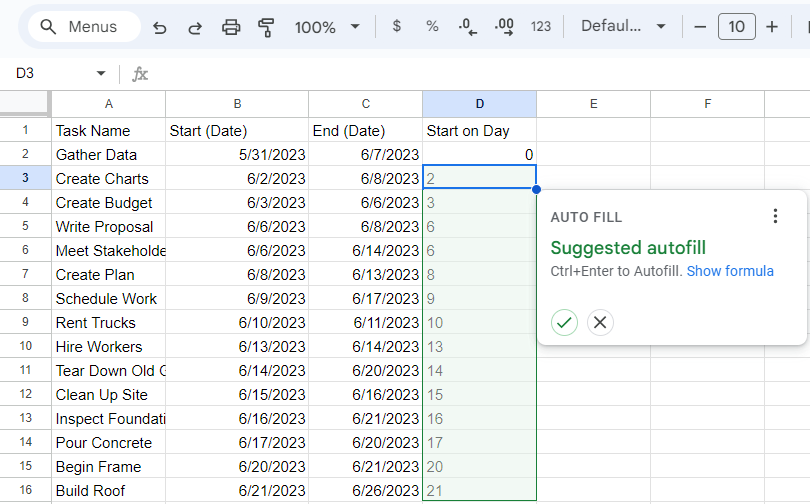
3. Calculate the Duration of Each Task in the Google Sheets Gantt Template
Create a column to calculate the duration of each task. To do so, repeat the process from step two, type duration as the column title, and then enter the formula “=C2-B2.”
Google Sheets will again suggest you use the autofill feature to populate the rest of the column. This is the last column you’ll need to make your Gantt chart in Google Sheets.
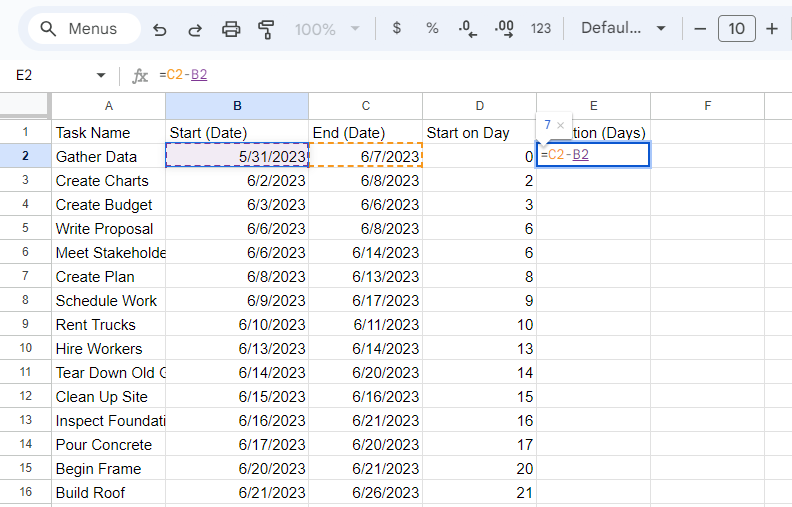
4. Insert a Chart in Google Sheets
Now, select all the values in column “A.” Then hold the “Control” key on your Windows PC keyboard or the “Command” key if you’re using a Mac. While you press on that key, select all values in columns “D” and “E” as well.
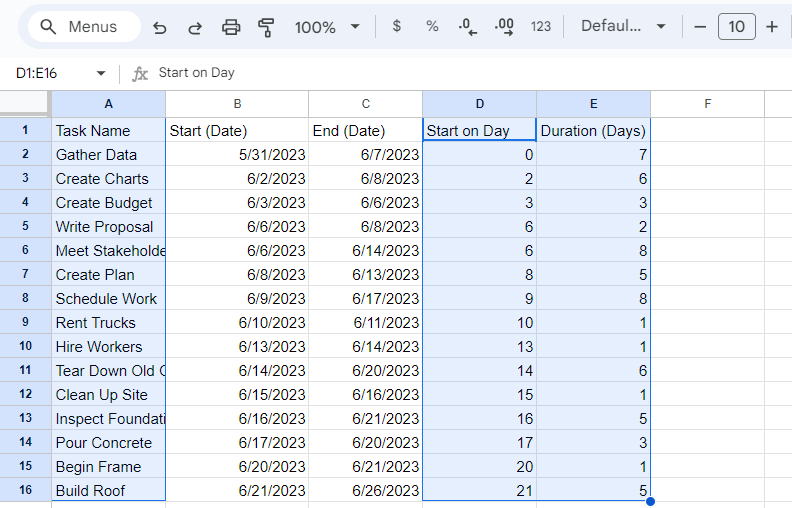
Then, while the columns are selected, click “Insert” at the top of your screen as shown below, and then click “Chart.”
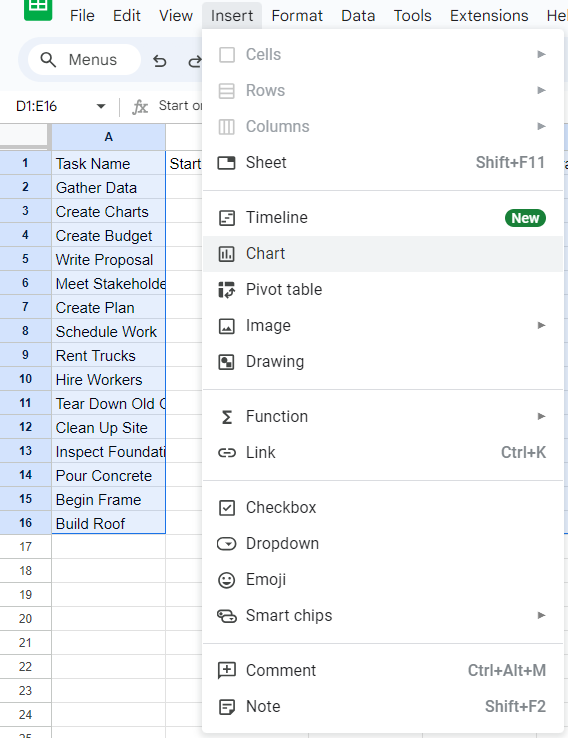
5. Select the Stacked Bar Chart to Get the Gantt Chart Look
Once you complete step four, a chart will appear on your Google Sheets spreadsheet. However, this isn’t the right type of chart you’ll need to create a Google Sheets Gantt chart. Now click on the “Chart type” dropdown menu on the right side of your screen.
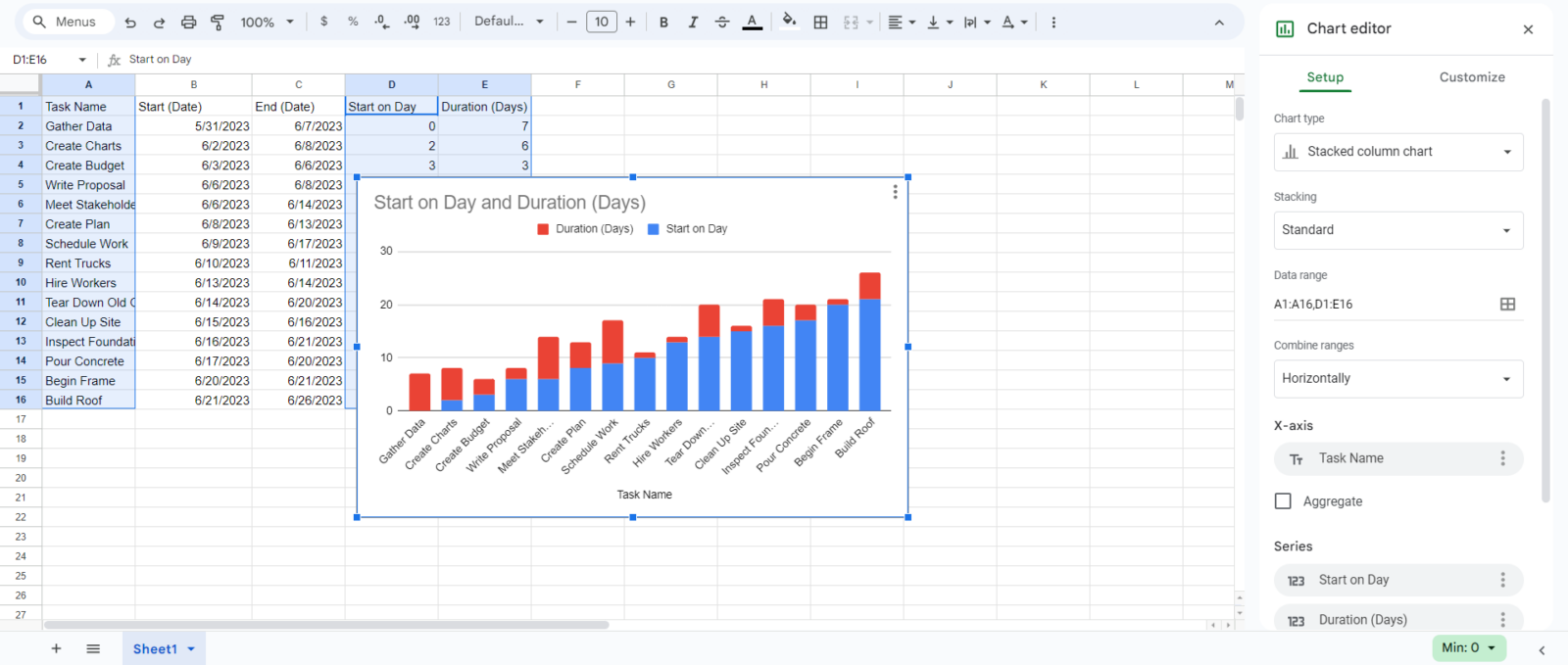
Scroll down through the chart options and select the stacked bar chart. This is the type of chart used for creating a Google Sheets Gantt chart.
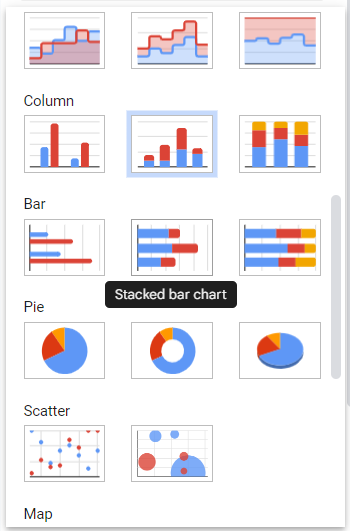
6. Format the Stacked Bar Chart to Look like a Timeline in Google Sheets
Once you complete step five, your chart should look like the image below.
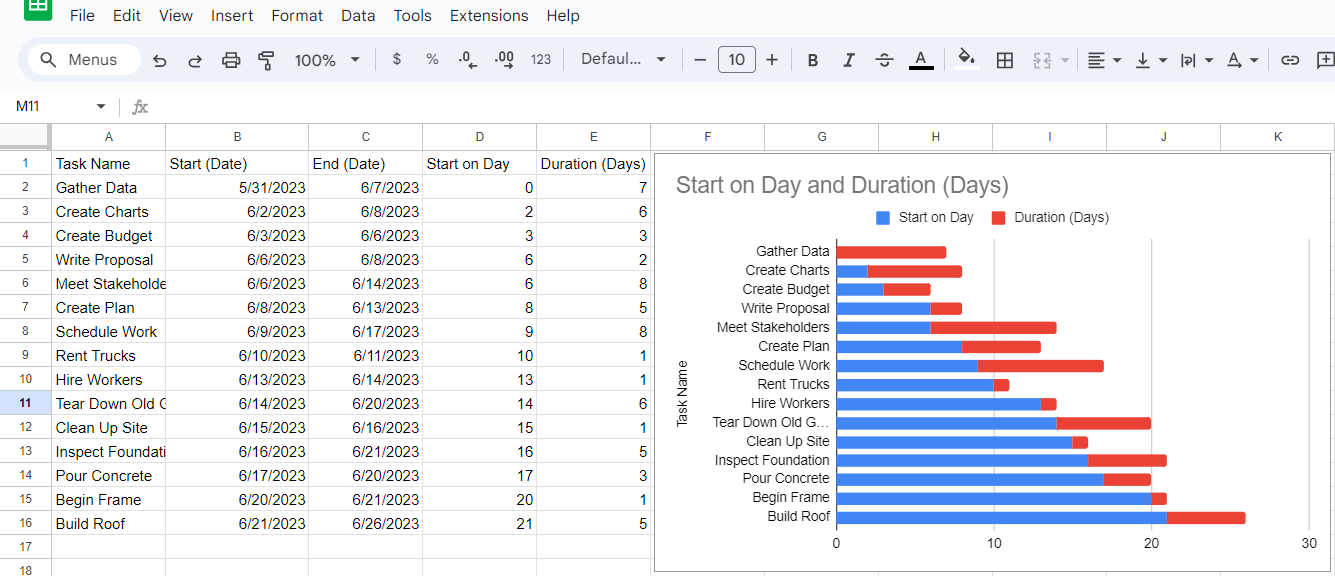
You may want to keep the chart title and legend, but for this Google Sheets Gantt chart, we’ve decided to remove the title and legend. If you wish to do so, simply double-click them and then once they’re selected press the “delete” key on your keyboard.
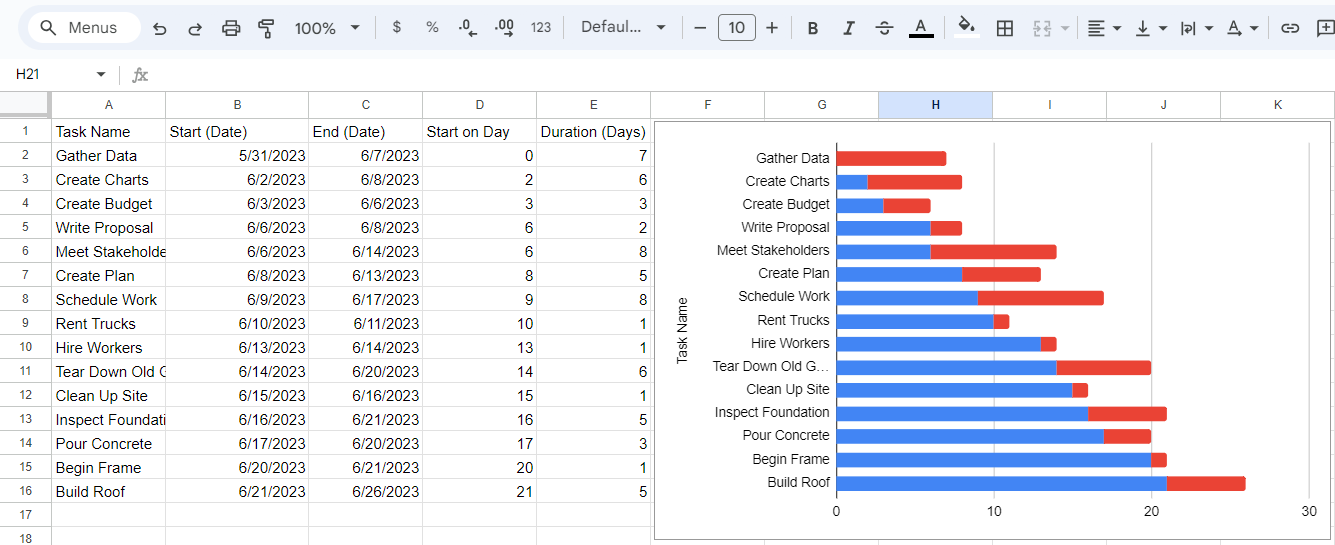
Now double-click your stacked bar chart and click “customize” on the right side of your screen. Then select “Gridlines and ticks” to format the horizontal axis values.
These values measure your project timeline in days. Set up your Gantt chart as shown below to set a scale that works for you. In this case, we’ve selected “step” as the “major spacing type” and an interval of five days for the horizontal axis.
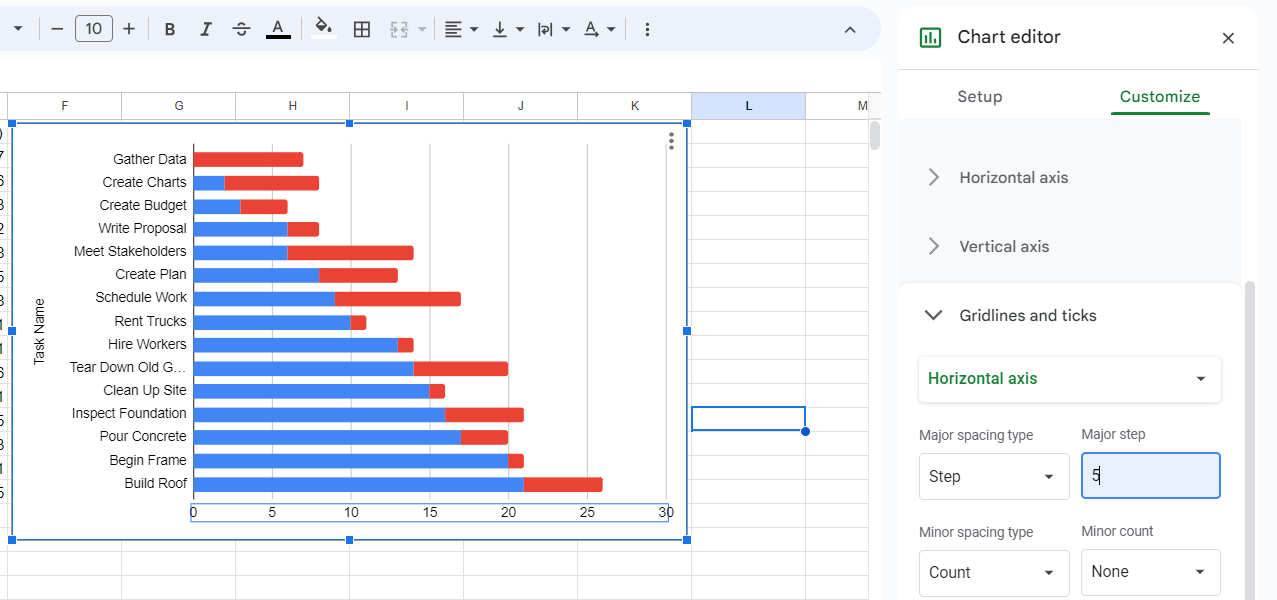
Now, double-click the blue bars. Once they’re all selected, a menu will appear on the right. On that menu, click fill color and select theme color white as shown in the image below. This will make the blue bars disappear to make your stacked bar chart look like a Gantt chart.
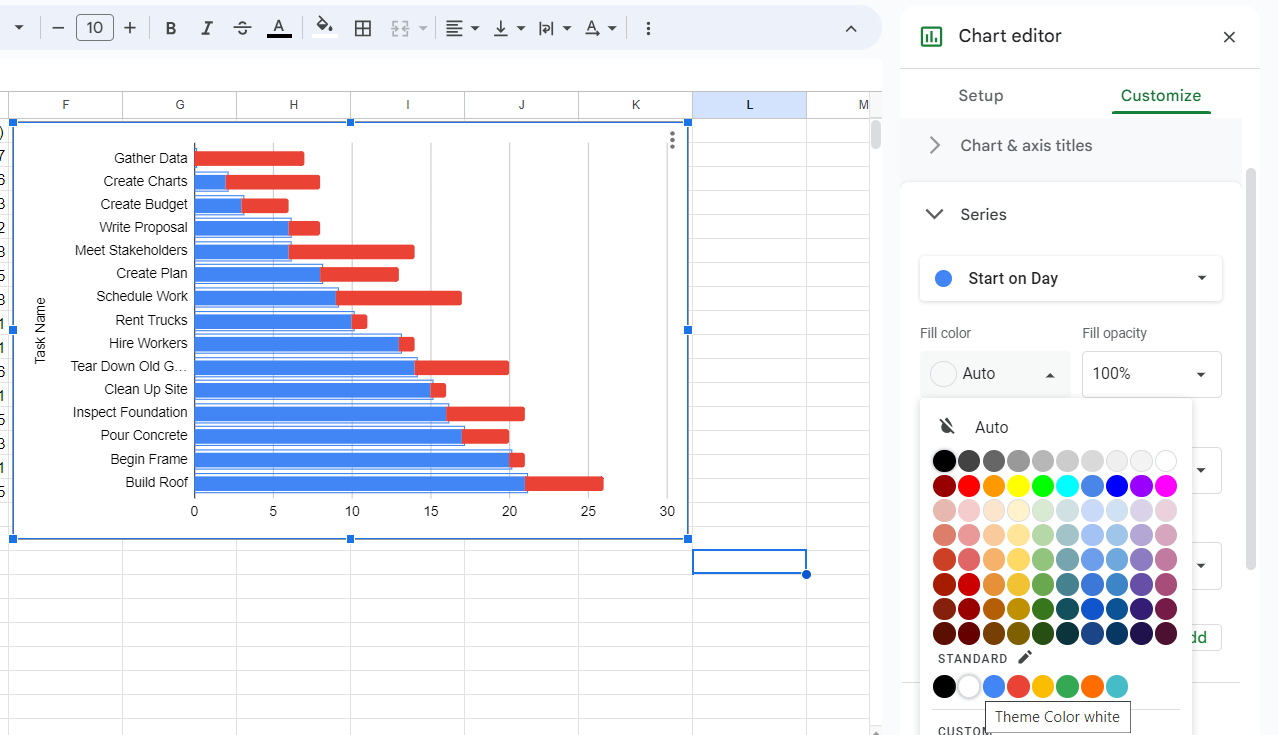
Congratulations! You’ve created a Google Sheets Gantt chart.

Now, you might want to change the color of each individual bar of your Gantt chart to better distinguish each task. If you wish to do so, simply double-click a red bar. This will select all your Google Sheets Gantt chart bars. Then click once again to select an individual bar and choose a unique fill color for each.
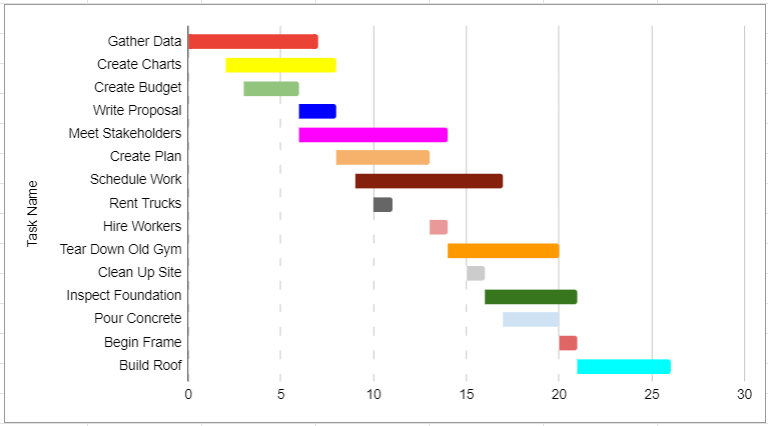
Join the thousands of teams that already succeeded with our tool. See why NASA, Bank of America and Ralph Lauren have chosen to use us when managing their projects. Don’t bother with Google or Excel, upload that file and get productive. Take our free 30-day trial today.


